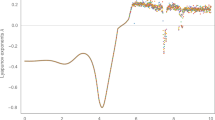Abstract
The variability of the duration of the cell cycle is explained by the phenomenon of sensitive dependence upon initial conditions; as may occur in deterministic non-linear systems. Chaotic dynamics of a system is the result of this sensitive dependence. First a deterministic system is formulated that is equivalent to the Smith-Martin transition probability model of the cell cycle. Next the model is extended to a dynamic process that ranges over the cell generations. A deterministic non-linear relationship between the cycle time of the mother and daughter cell is established. It clarifies the variability of mother-daughter correlation for the different cell types. The model is fitted to two different cell cultures; it shows that the graph of the non-linear relation has the same shape for different cell types.
Similar content being viewed by others
Literature
Brooks, R. F., D. C. Bennett and J. A. Smith. 1980. Mammalian cell cycles need two random transitions.Cell 19, 493–504.
Constantin, P., C. Foias, O. P. Manley and R. Temam. 1985. Determining modes and fractal dimensions of turbulent flows.J. Fluid Mech.,150, 427–440.
Grasman, J., J. A. Aten, J. Stap and Th. J. Smit. 1987. A generalized transition model of the cell cycle and its application to experimental data of tumour cell proliferation. Preprint 451, Dept. of Mathematics, University of Utrecht.
Hejblum, G., D. Costagliola, A.-J. Valleron and J.-Y. Mary. 1988. Cell cycle models and mother-daughter correlation.J. theor. Biol.,131, 255–262.
Mackey, M., M. Santavy and P. Selepova. 1986. A mitotic oscillator with a strange attractor and distribution of cell cycle times. In:Nonlinear Oscillations in Biology and Chemistry (Lecture Notes in Biomathematics, Vol. 66), H. G. Othmer (ed.), pp. 34–45. Berlin: Springer.
May, R. M. 1976. Simple mathematical models with very complicated dynamics.Nature 216, 459–467.
Mayer-Kress, G. 1986.Dimensions and Entropies in Chaotic Systems: Quantification of Complex Behavior. Berlin: Springer.
Schaffer, W. M., S. Ellner and M. Kot. 1986. Effects of noise on some dynamical models in ecology.J. math. Biol. 24, 479–523.
Shaw, R. 1981. Strange, attractors, chaotic behaviour and information flow.Z. Naturforsch. 36a, 80–112.
Shymko, R. M., R. R. Klevecs and S. A. Kauffman. 1984. The cell cycle as an oscillatory system. InCell Cycle Clocks, L. N. Edmunds (ed.), pp. 273–293. New York: Marcel Dekker.
Smith, J. and L. Martin. 1973. Do cells cycle?Proc. natl Acad. Sci. U.S.A. 70, 263–267.
Van Zoelen, E. J. J., P. T. van der Saag and S. W. de Laat. 1981. Family tree analysis of transformed cell line and the transition probability model for the cell cycle.Exp. Cell Res. 131, 395–406.
Author information
Authors and Affiliations
Rights and permissions
About this article
Cite this article
Grasman, J. A deterministic model of the cell cycle. Bltn Mathcal Biology 52, 535–547 (1990). https://doi.org/10.1007/BF02462266
Received:
Revised:
Issue Date:
DOI: https://doi.org/10.1007/BF02462266




